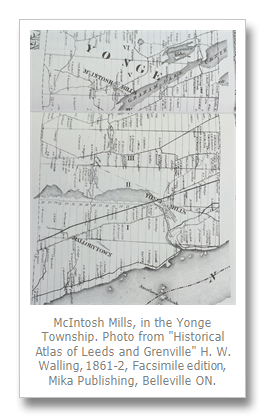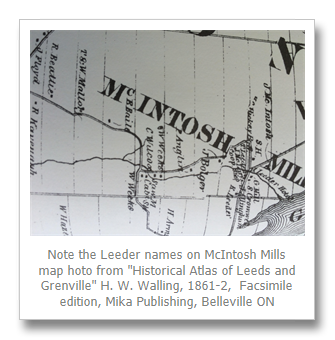Robert Leeder is my favourite ancestor, not because he did anything earth shaking but he managed to leave a wonderful paper trail and many stories about his life. He was one of the original settlers in Yonge Township, Leeds County and he participated in some important moments in history such as the Napoleonic wars and the War of 1812. Robert left a large number of descendents in Leeds County and the rest of the continent.
He was born in 1794 in the tiny village of Elmswell in Suffolk, England at the beginning of the Napoleonic Era. In December of 1811, caught up in the excitement of Napoleon’s threat to England, he enlisted in the Chatham Division of the Royal Marines, 73rd Company. On his attestation papers there is a record of him receiving an £8 signing bonus.
Here we enter into family lore. Separating fact from fiction has become an interesting challenge. It seems he was a master story teller. This was long before the advent of radio and television and people made their own entertainment. The stories of his adventures in the Marines appear to have been a staple in the Leeder household. Entertaining his children on those long cold winter nights in the Canadian wilderness had a lasting impact as six generations later variations of those stories are still told by his descendents.
The Marine stories fall into three categories: 1) he served on one of the ships that carried Napoleon to Elba in one variation or to St Helena in the other; 2) he was one of the Marines who participated in the Battle of Bladensburg and the subsequent burning of the public buildings in Washington in 1814; 3) he fought under Wellington at the Battle of Waterloo in 1815.
Curious about all these stories, I began to do a bit of research. We can get number 3 out of the way first. I contacted the British Royal Marine Museum in Portsmouth England. Their reply was short but definitive, there were no Marines at the Battle of Waterloo. That took the credibility of the stories down a peg. So, how accurate were the other stories?
Next, I tackled the burning of Washington story. Here I found much better fodder. There were two battalions of Marines that participated, one of which was drawn from the ships of the English fleet in Chesapeake Bay. Each ship had, as a rule of thumb, one Marine for each gun, plus officers. Therefore a ship of 100 guns would have 100 Marines and their officers on board. Even a small fleet of ships could produce a large number Marines for shore combat. Here my research began to bog down. In order to identify him I would need to know on which ship he served. I knew he was in the Chatham 73rd Company but no unit diaries were kept as the Marines were, in practice, assigned ‘willy nilly’ to various ships of the fleet, probably the ones that sailed out of Chatham. And, once on board, they were under naval authority and those records were kept by the Admiralty. How to find which ship? To compound the problem, at the peak of the Napoleonic campaign (which included the War of 1812), England had about 700 ships in service and 31,000 Marines. After the battles at Washington one of the battalions of Marines was transferred to the Great Lakes to bolster the forces in Upper Canada. The Leeder stable of stories don’t mention this so it is unlikely he served in Upper Canada. So, although he fought in the War of 1812, he never set foot in Canada during that time.
An interesting fact that speaks in favour of this story being true is revealed in the Upper Canada Land Petitions. In 1832 he applied for a grant of land as a discharged soldier of the Chatham Royal Marines. Unfortunately for him, but fortunately for us, he had lost his discharge papers and applied with an affidavit. The land board refused his application, “other proof required”. Never one to call it quits, he went to the Kingston Naval ship yards. The commander there was Robert Barrie. Barrie was well positioned to know if Robert Leeder was a fraud or not. He had served in the American campaign in 1813 and 1814 as Captain of the 74 gun HMS Dragon amongst other roles. He was close to Sir George Cockburn, the commander of the American campaign. Cockburn’s biography “The man who burned the White House, Admiral Sir George Cockburn, 1772-1853” by James Pack (1987) mentions Barrie several times. In fact, the first ship launched in Kingston under Barrie’s command was the “Cockburn.” Cockburn was also the man who took Napoleon to St Helena.
We can only speculate on the conversation that took place but in his letter to the Land Council Barrie recommended a land grant for Robert Leeder as ‘a marine in the late war’. There are a couple of things that should be noted here. Barriefield, on the east side of the causeway approaching Kingston was named after him, as was the city of Barrie, north of Toronto. The land Robert Leeder received for his all his troubles, in Escott Township (east of Lansdowne), was, and is, nothing but rock and swamp. The property lies at the foot of Blue Mountain. It is now part of Charleston Provincial Park north of Lansdowne. Anyone who has hiked to the top of Blue Mountain knows the type of land well.
This brings us to transporting Napoleon to exile. After some research I am favouring the Elba version for the following reasons. The “HMS Undaunted” took Napoleon to Elba and although it stayed there, one of its companion ships, “HMS Euryalus,” formed up a fleet and headed for service on the American east coast. The time frame is right for Robert to be off the American coast. With Napoleon safely tucked away on Elba the British could free up more war ships and battle seasoned troops to deal with the Americans.
The St Helena story has some serious flaws even though the “HMS Bellerophon” is specifically mentioned in some of the Leeder stories. The “Bellerophon” never saw service in North America. Although famous in its time for taking Napoleon into custody off the French coast it never went to St Helena. When it returned to England with Napoleon it was decommissioned due to its age and turned into a prison ship. Napoleon was transferred to and went into exile on the “HMS Northumberland.” The ships in that fleet stayed at St Helena until sometime in 1816. This was after Robert was demobilized in late 1815 or early 1816. Since peace had broken out most of the Marines were demobilized and their numbers were cut from 31,000 to about 6,000.

All we can say for sure at this time is that, except for the “Waterloo thing”, his Marine career, as outlined in the family stories, closely parallels actual events. Without much more in depth research we can’t be sure on which ship or ships he served and therefore discover more about his Marine career. A search of the Admiralty records would necessitate tracking down the names of the all the ships in the American campaign and cross referencing them with the ships involved in transporting Napoleon to Elba and St Helena. Only then would a search of the Admiralty records possibly yield any positive results. A daunting task. Regardless of the results of my search one thing can never change. His stories have entertained and intrigued his descendants to this day.

Robert Leeder immigrated to Canada in 1825 and was settled in Yonge Township by 1832. While he was seeking the land grant (which became a disaster) he had settled on a much better property at what is now the ‘hamlet’ of McIntosh Mills and that became the Leeder homestead. He had a large family and his children had large families. This multitude of descendants have spread all over North America. Many have cottages on Charleston Lake but some have made the River their summer home.
One of his descendants was Robert John Deir of RJ Deir and Sons store in Gananoque. RJ moved from Lansdowne and founded the store in the early 1900s. His family had cottages on Tremont Island for several generations. One of RJ’s grandsons, Richard Cliffe, a retired businessman and former Town Councilor still enjoys his cottage on the island. Another of his many grand children was Jack Leeder who moved from McIntosh Mills and established Leeder Monuments in Gananoque in the late 1890s. One of Jack’s grand children, John Keilty, is an islander and the owner of the Gananoque Inn.
Others, that I know of, are Professor James Coté who has a cottage in ‘Baie Coté’ on Stave Island and Dan Baldock, a retired IT executive, on Downey Island. In one of the wonderful ways genealogical relationships are described Jim and Dan are ½ third cousins, once removed. And finally (this is for the hockey fans out there) the president of the Ottawa Senators, a NHL team, is Cyril Leeder. He is another descendent.
By Paul Coté
Paul Coté is a resident of Gananoque. He has socialized and worked on the river for most of his life. History has always been a passion and he is a self confessed genealogy addict. Recently retired from contracting on the river, he now has time to pursue and write about his research. He is currently writing a book about the 500 year history of the Leeder family.